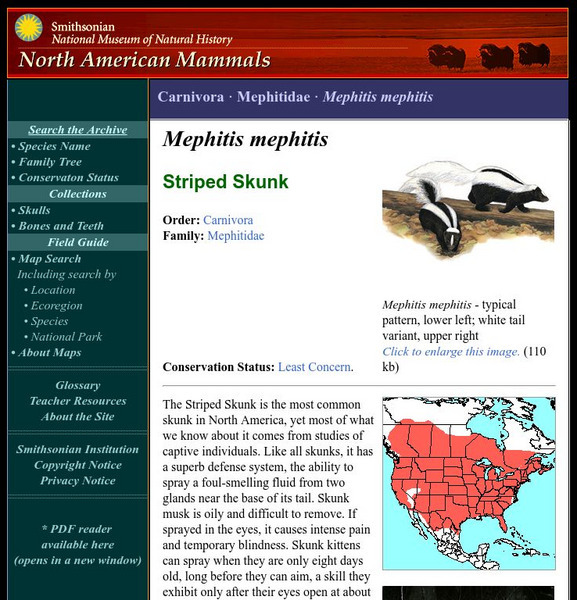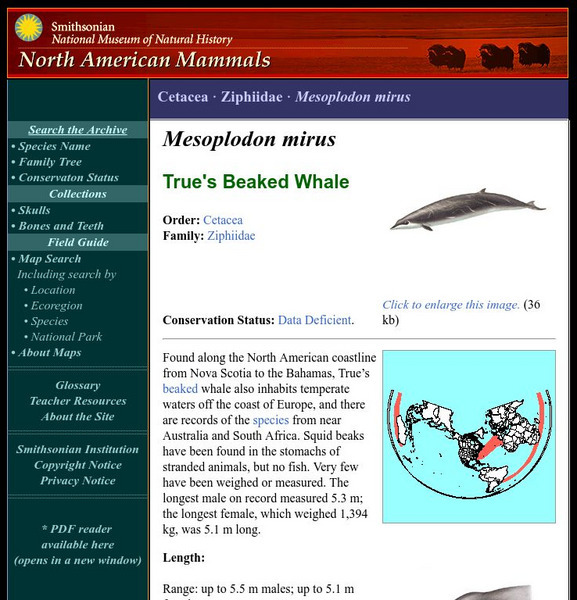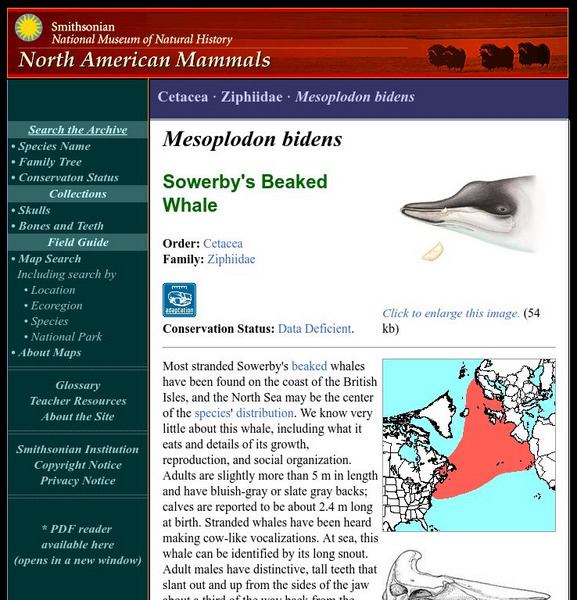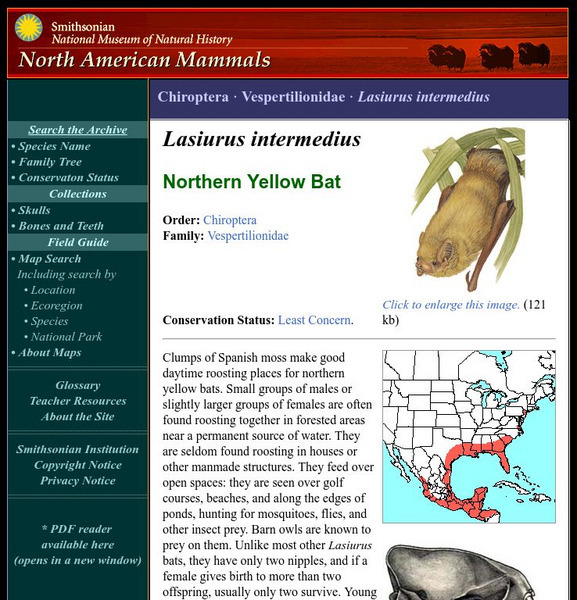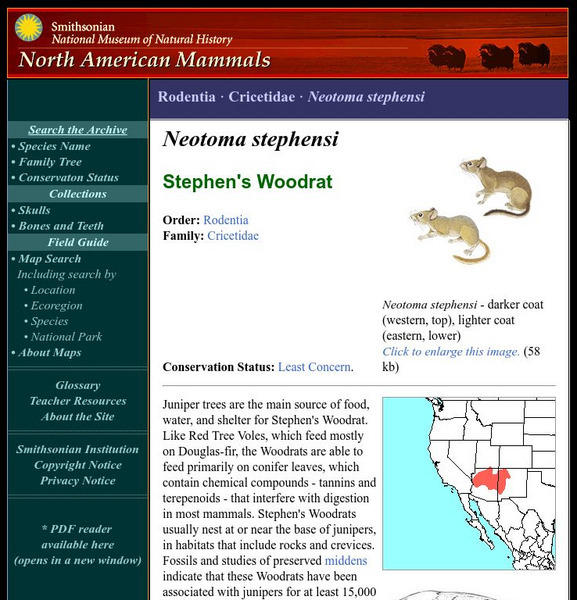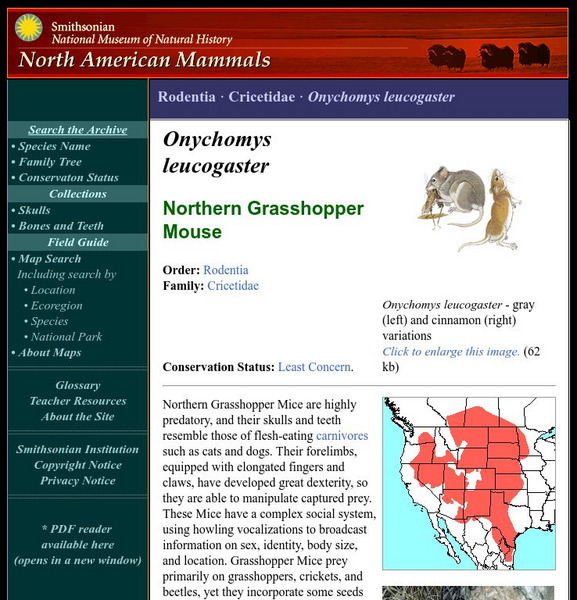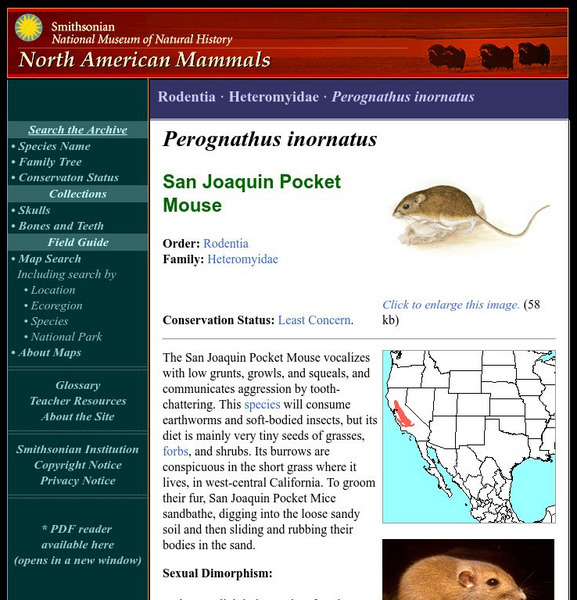Smithsonian Institution
National Museum of Natural History: American Mammals: Vancouver Marmot
Vancouver Marmots live only on Vancouver Island, British Columbia. They are the only endangered mammal in Canada, with a population estimated at only 100-200 individuals. Learn more about the Marmota vancouverensis, more commonly known...
Smithsonian Institution
National Museum of Natural History: American Mammals: Striped Skunk
The Striped Skunk is the most common skunk in North America, yet most of what we know about it comes from studies of captive individuals. Like all skunks, it has a superb defense system, the ability to spray a foul-smelling fluid from...
Smithsonian Institution
National Museum of Natural History: American Mammals: True's Beaked Whale
Found along the North American coastline from Nova Scotia to the Bahamas, True's beaked whale also inhabits temperate waters off the coast of Europe, and there are records of the species from near Australia and South Africa. Squid beaks...
Smithsonian Institution
National Museum of Natural History: American Mammals: Sei Whale
Unlike other rorquals, Sei whales have a dolphin-like dorsal fin. They are also unusual in using two different methods to fill their mouths with water during feeding - they both gulp and skim-feed. Learn more about the Balaenoptera...
Smithsonian Institution
National Museum of Natural History: American Mammals: Sowerby's Beaked Whale
Most stranded Sowerby's beaked whales have been found on the coast of the British Isles, and the North Sea may be the center of the species' distribution. We know very little about this whale, including what it eats and details of its...
Smithsonian Institution
National Museum of Natural History: American Mammals: Seminole Bat
Seminole bats, sometimes called mahogany bats, can be mistaken for red bats where the two species overlap (the red bat has a much larger range). The two are similar in color, size, and appearance. Learn more about the Lasiurus seminolus,...
Smithsonian Institution
National Museum of Natural History: American Mammals: Northern Yellow Bat
Clumps of Spanish moss make good daytime roosting places for northern yellow bats. Small groups of males or slightly larger groups of females are often found roosting together in forested areas near a permanent source of water. Learn...
Smithsonian Institution
National Museum of Natural History: American Mammals: Olympic Marmot
Olympic Marmots are highly social, living in groups made up of an adult male, one or more adult females, two-year-olds, yearlings, and young. Their diet consists of grasses and sedges, with flowering plants in season. Learn more about...
Smithsonian Institution
National Museum of Natural History: American Mammals: Pale Kangaroo Mouse
Most Pale Kangaroo Mice live in high, cold desert in Nevada; there is also a small population in eastern California. They look like small kangaroo rats, and like them, can hop on their large hind feet. Learn more about the Microdipodops...
Smithsonian Institution
National Museum of Natural History: American Mammals: Woodland Jumping Mouse
Woodland Jumping Mice can make spectacular leaps of up to 4 m. They have large feet constructed from long foot and toe bones, and very long ankles, all of which help give them leverage when they push off. Learn more about the Napaeozapus...
Smithsonian Institution
National Museum of Natural History: American Mammals: White Throated Woodrat
Woodrats are also known as Packrats, because they cache various manmade objects in their dens. This habit of collecting foreign objects is useful to scientists, who can place numbered sticks throughout an area and later open a den,...
Smithsonian Institution
National Museum of Natural History: American Mammals: Stephen's Woodrat
Juniper trees are the main source of food, water, and shelter for Stephen's Woodrat. Like Red Tree Voles, which feed mostly on Douglas-fir, the Woodrats are able to feed primarily on conifer leaves, which contain chemical compounds -...
Smithsonian Institution
National Museum of Natural History: American Mammals: Southern Plains Woodrat
Southern Plains Woodrats are found in places where grasses, creosotebush, mesquite, and cactus grow. Local populations can reach high levels and then crash. Learn more about the Neotoma micropus, more commonly known as a Southern Plains...
Smithsonian Institution
National Museum of Natural History: American Mammals: Mexican Woodrat
Mexican Woodrats inhabits rocky outcrops, cliffs, and slopes, primarily in montane regions from northern Colorado to Honduras. They eat a wide variety of leaves, seeds, and berries, and sometimes store large amounts of food. Learn more...
Smithsonian Institution
National Museum of Natural History: American Mammals: Mearn's Grasshopper Mouse
Grasshopper Mice are adapted to a predatory lifestyle. Their molar teeth have high-cusped shearing surfaces for puncturing and slicing, and their biting strength is increased through enlarged muscle attachments on the lower jaw and...
Smithsonian Institution
National Museum of Natural History: American Mammals: Southern Grasshopper Mouse
Southern Grasshopper Mice are also known as scorpion Mice: they are able to kill (and then eat) scorpions, by first immobilizing the venomous tail and then biting the head. They also prey on beetles that secrete defensive chemicals from...
Smithsonian Institution
National Museum of Natural History: American Mammals: Northern Grasshopper Mouse
Northern Grasshopper Mice are highly predatory, and their skulls and teeth resemble those of flesh-eating carnivores such as cats and dogs. Their forelimbs, equipped with elongated fingers and claws, have developed great dexterity, so...
Smithsonian Institution
National Museum of Natural History: American Mammals: San Joaquin Pocket Mouse
The San Joaquin Pocket Mouse vocalizes with low grunts, growls, and squeals, and communicates aggression by tooth-chattering. This species will consume earthworms and soft-bodied insects, but its diet is mainly very tiny seeds of...
Smithsonian Institution
National Museum of Natural History: American Mammals: Silky Pocket Mouse
The smallest Perognathus species of all, the Silky Pocket Mouse is among the smallest rodents in North America. These Mice are most active on cool, humid nights, typically foraging for fallen seeds by sifting sand with their tiny...
Smithsonian Institution
National Museum of Natural History: American Mammals: White Eared Pocket Mouse
One subspecies of the White-eared Pocket Mouse may be extinct, and the other is extremely rare, consisting of isolated, relict populations near the western Mojave Desert in California. White-eared Pocket Mice are nocturnal and probably...
Smithsonian Institution
National Museum of Natural History: American Mammals: Plains Pocket Mouse
The color of the Plains Pocket Mouse varies with soil color. The black volcanic sands near Flagstaff, Arizona harbor mice with nearly black fur, and mice with nearly white fur match the white gypsum dunes of New Mexico. Learn more about...
Smithsonian Institution
National Museum of Natural History: American Mammals: Olive Backed Pocket Mouse
The striking olive dorsum of the Olive-backed Pocket Mouse is set off by a yellowish stripe on the side and a white underside. This is the only species of pocket mouse east of the Rocky Mountains whose range extends well into Canada....
Smithsonian Institution
National Museum of Natural History: American Mammals: Merriam's Pocket Mouse
Merriam's Pocket Mice are found in short-grass prairie, desert scrub, and open, arid brushland. They are most common where the vegetation is dense enough to provide them with seeds and some protection from predators, but not so dense...
Smithsonian Institution
National Museum of Natural History: American Mammals: Texas Mouse
Texas Mice need rocky environments. Where these occur, they are found in cedar glade, juniper-grass, and oak-juniper forests. Learn more about the Peromyscus attwateri, more commonly known as a Texas Mouse, in this easy-to-read species...

